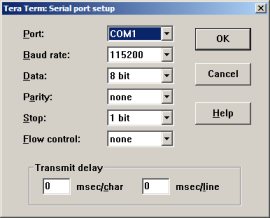 |
Embedded TCP/IP stack
4.1.0
|
FNET Shell mbedTLS Demo Quick Start
Requirements
Tools used during this quick start:
- Supported IDE.
- Terminal program (Tera Term Pro v4.63 http://ttssh2.sourceforge.jp).
- WEB browser.
- FNET project source code, coming with this document.
Step by step
Follow these steps to run the FNET Shell demo application:
- Prepare your evaluation board according to your board User Manual.
- Use USB or RS-232 male/female DB-9 serial cable to connect your PC (through COM port) to the evaluation board.
- Connect the evaluation board to an Ethernet network.
- Power the board up.
- Invoke the terminal program on the PC to which the evaluation board is connected and configure it to:
- Bits per second: 115200.
- Data bits: 8.
- Parity: none.
- Stop bits: 1.
- Flow control: None.
 Serial port setup
Serial port setup
- Launch IDE.
- Open the project:
fnet\fnet_demos\boards\<board_name>\shell_mbedtls\<compiler_name>\
- In the IDE, choose a project target you want to compile.
- Compile, load (or flash) the application to the board and run the project.
- In your terminal program window you should see the FNET application welcome message:
************************************************ FNET Shell Application (mbedTLS) ************************************************ FNET TCP/IP Stack for MK64FN1 Version 4.0.0 Built Oct 26 2017 at 14:14:13 by IAR Enter '?' for command list. ************************************************ [FAPP] Application parameters loaded from Flash. SHELL> [LINK] eth0: connected => Script: dhcpc autoip -n eth0; mdns -n eth0; llmnr -n eth0; ************************************************ DHCPv4 Client started. Interface : eth0 ************************************************ Press [Ctr+C] to cancel. [DHCP] Discovering... ************************************************ IPv4 parameters updated : ************************************************ Ethernet Interface <default>: Name : eth0 ScopeID : 1 Media State : connected IPv4 Address : 192.168.0.102 <dhcp> IPv6 Address : fe80::211:22ff:fe33:4455 <autoconfigurable> IPv4 Subnet mask : 255.255.255.0 IPv4 Gateway : 192.168.0.1 IPv4 DNS : 192.168.0.1 DHCP Client : on DHCP Server Address : 192.168.0.1 AUTOIP Service : off LLMNR Server : off MDNS Server : off ************************************************ mDNS server started. Interface : eth0 Host Name : fnet ************************************************ ************************************************ LLMNR server started. Interface : eth0 Host Name : fnet ************************************************ SHELL>
- This application has absolutely the same features and behavior as the Shell demo application. So before next steps, read about it in FNET Shell Demo Quick Start.
- You can run the HTTPS Server on the board, by typing the command
httpsinto your terminal program window.
In your terminal program window you should see:SHELL> https ************************************************ HTTPS server started. IPv4 Address : 192.168.0.103 IPv6 Address : fe80::211:22ff:fe33:4455 ************************************************ SHELL>
- Then run your Web browser and navigate to the server address (the address you have assigned to the system or obtained from the DHCP server):
https:// 192.168.0.103
orhttps:// [fe80::211:22ff:fe33:4455]
- Depending on the used Web browser, you may get a warning message about that there is a problem with the security certificate. It occurs because the demo HTTPS server uses the test security certificate which was not signed by a trusted certificate authority. But a real application should use a valid certificate acquired from one of trusted certificate authorities.
So just ignore this warning and continue to the website. - You should see a Web page served by the FNET HTTPS server. The HTTPS server uses the same Web pages as the normal HTTP server but transfered over the TLS protocol set.
- Note
- The application project includes mbedTLS library (https://tls.mbed.org/). Its source code is located in fnet/third_party/mbedtls-x.x.x/.
- The mbedTLS FNET application configuration parameters are in the fnet_mdedtls_user_config.h file.
- The MBEDTLS_CONFIG_FILE definition is set to "fnet_mbedtls_user_config.h" in preprocessor project options.
© 2005-2018 by Andrey Butok. http://fnet.sourceforge.net